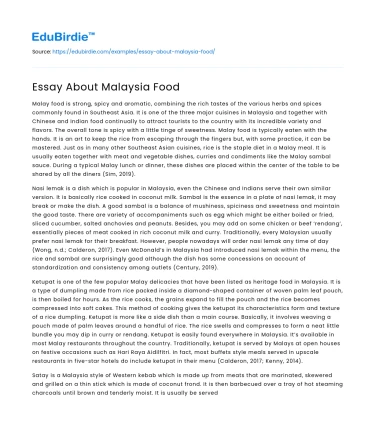Malay food is strong, spicy and aromatic, combining the rich tastes of the various herbs and spices commonly found in Southeast Asia. It is one of the three major cuisines in Malaysia and together with Chinese and Indian food continually to attract tourists to the country with its incredible variety and flavors. The overall tone is spicy with a little tinge of sweetness. Malay food is typically eaten with the hands. It is an art to keep the rice from escaping through the fingers but, with some practice, it can be mastered. Just as in many other Southeast Asian cuisines, rice is the staple diet in a Malay meal. It is usually eaten together with meat and vegetable dishes, curries and condiments like the Malay sambal sauce. During a typical Malay lunch or dinner, these dishes are placed within the center of the table to be shared by all the diners (Sim, 2019).
Nasi lemak is a dish which is popular in Malaysia, even the Chinese and Indians serve their own similar version. It is basically rice cooked in coconut milk. Sambal is the essence in a plate of nasi lemak, it may break or make the dish. A good sambal is a balance of mushiness, spiciness and sweetness and maintain the good taste. There are variety of accompaniments such as egg which might be either boiled or fried, sliced cucumber, salted anchovies and peanuts. Besides, you may add on some chicken or beef ‘rendang’, essentially pieces of meat cooked in rich coconut milk and curry. Traditionally, every Malaysian usually prefer nasi lemak for their breakfast. However, people nowadays will order nasi lemak any time of day (Wong, n.d.; Calderon, 2017). Even McDonald’s in Malaysia had introduced nasi lemak within the menu, the rice and sambal are surprisingly good although the dish has some concessions on account of standardization and consistency among outlets (Century, 2019).
Save your time!
We can take care of your essay
- Proper editing and formatting
- Free revision, title page, and bibliography
- Flexible prices and money-back guarantee
Ketupat is one of the few popular Malay delicacies that have been listed as heritage food in Malaysia. It is a type of dumpling made from rice packed inside a diamond-shaped container of woven palm leaf pouch, is then boiled for hours. As the rice cooks, the grains expand to fill the pouch and the rice becomes compressed into soft cakes. This method of cooking gives the ketupat its characteristics form and texture of a rice dumpling. Ketupat is more like a side dish than a main course. Basically, it involves weaving a pouch made of palm leaves around a handful of rice. The rice swells and compresses to form a neat little bundle you may dip in curry or rendang. Ketupat is easily found everywhere in Malaysia. It’s available in most Malay restaurants throughout the country. Traditionally, ketupat is served by Malays at open houses on festive occasions such as Hari Raya Aidilfitri. In fact, most buffets style meals served in upscale restaurants in five-star hotels do include ketupat in their menu (Calderon, 2017; Kenny, 2014).
Satay is a Malaysia style of Western kebab which is made up from meats that are marinated, skewered and grilled on a thin stick which is made of coconut frond. It is then barbecued over a tray of hot steaming charcoals until brown and tenderly moist. It is usually be served with delicious peanut sauce, some cucumber, onion and even some Malays will enjoy it with ketupat which is the Malay rice dumpling. It can be easily found in restaurants, food courts and night markets throughout every state in Malaysia. The popular kinds of satays are usually made with beef and chicken. However, different regions in Malaysia have developed their own unique Satay recipes. Sate is often associated with Muslim Malays, but pork sate is also available at non-halal Chinese eating establishments. There are also other unique variations of satay like satay lok-lok from Penang and satay celup from Malacca. Both are Malaysian Chinese combination of the hotpot and the Malay satay where raw meat pieces, tofu pieces, quail eggs, fish cakes, vegetable pieces and any kind of suitable food are skewered on bamboo sticks (Malaysia Truly Asia, n.d.; Wong, n.d.).
So, in conclusion, food in Malaysia is characterized by its uniqueness, multiculturalism and incredible taste. Malay cuisine, as one of its cuisines, is characterized by a large number of unique traditional dishes that tempt the taste buds and give unforgettable pleasure.






 Stuck on your essay?
Stuck on your essay?

